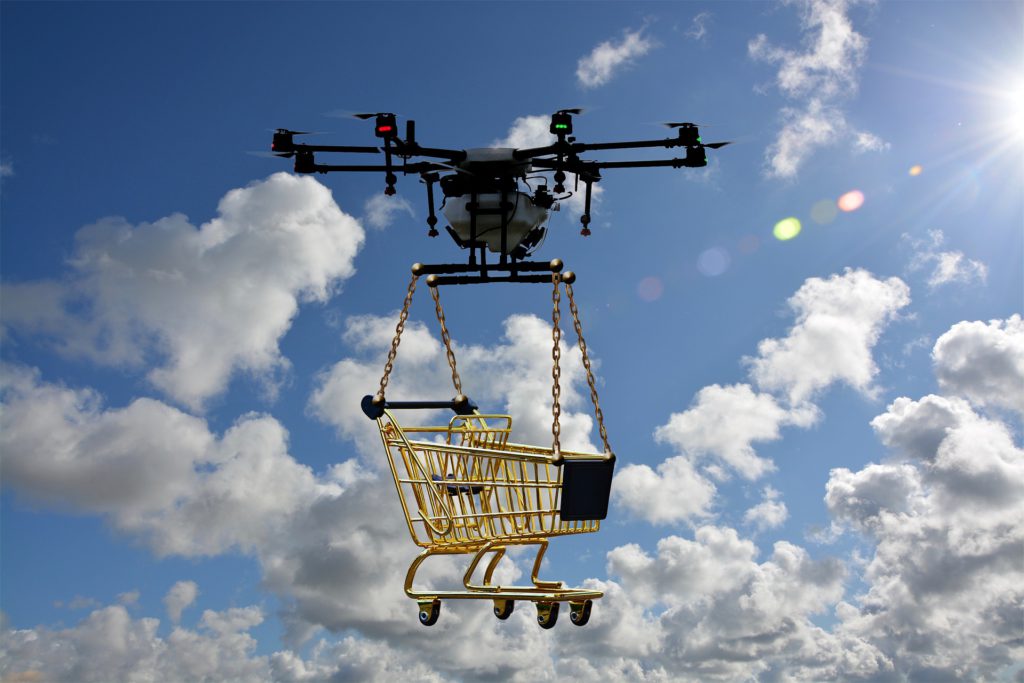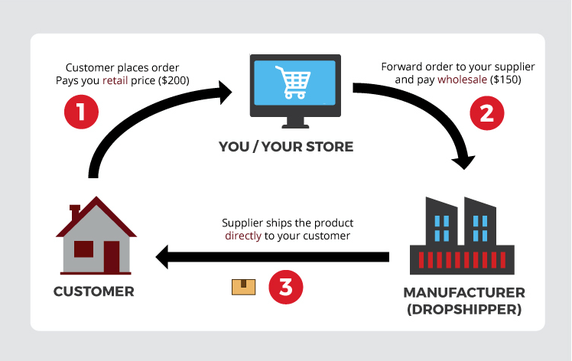Dropshipping – Can You Legitimately Make Money From It or Is It a Scam?
You've seen the picture of guys sipping coconuts on the beach, claiming they work no more than a few hours per week from their laptops “dropshipping”. These guys often claim it is little work for a ton of money. If so, wouldn't everyone be doing it?
Not to say that you can't make money from dropshipping, but it's important to make sure you have an awareness of the facts before getting started.
In this evaluation of dropshipping itself, we'll explore the pros and cons of dropshipping – why it works and why it doesn't. Like any business venture, it's easy to lose money if you're not careful.
Contents
What is Dropshipping?
Dropshipping is the business of selling a wholesale supplier's physical products through your own online store. The supplier then ships directly to the customer, and you pocket the difference between the wholesale and retail prices.
This is a popular e-commerce model because of its low start-up costs: you don't need to handle inventory, deal with shipping and handling, or rent a warehouse to store your products. Some well known e-commerce retailers like Buy.com, Newegg, and Overstock.com are dropshippers.
All you need is a website through sites like Shopify or BigCommerce and you can start selling right away.
With almost no overhead and little risk, dropshipping can be a great way to make money online with a small starting budget.
Once you've decided to get started dropshipping, the next step is to find a supplier. On sites like Ali Express, SaleHoo, or Dropship Direct, you can partner up with potential suppliers and begin selling their products right away.
Then, once a customer places an order, this is how dropshipping works:
- The customer pays for the order and you receive money for the retail price.
- You send the shipping information to the supplier and pay the wholesale price of the order.
- The dropshipping supplier packages and ships the order to your customer with a receipt that makes it look like the package came directly from your online store.
- The difference between the wholesale and retail prices is your profit.
The Pros of Dropshipping
If you want to give dropshipping a try, it can be a legit path to making money and has a lot going for it. Besides it's low-risk and low start-up costs, it is a highly scalable e-commerce model. This means you can start with a small budget and increase it as your business grows.
Another factor is the convenience and the ability to run your business entirely from your laptop.
Additionally, here are some other benefits to consider…
Pro #1: Low Start-Up Costs
One of the best things about dropshipping is the fact that you can get started for little to nothing. You don't need to invest in a physical storefront or even incorporate as an LLC. It's possible to do business as a sole proprietor and get started right away.
However, to get started, you will need to spend a little bit of money. Running an online storefront doesn't need to break the bank, and you have a variety of options when it comes to creating your store.
The “all-inclusive” options handle everything for you or make it easy as possible. Through their platforms, setting up your storefront is a breeze — you can handle everything from website design to payment processing through their platforms.
Some of the most popular paid options include:
- Shopify – the most popular option on the market today ($29/month)
- BigCommerce – an extremely intuitive storefront builder ($29.95/month)
- Squarespace – a straightforward, all-in-one solution ($30/month)
However, if you don't want to pay for one of the all-inclusive options, you can go with Woocommerce, a WordPress-hosted solution. Woocommerce is an open-source, free plugin for WordPress hosted sites that you can use to build your online storefront.
However, with Woocommerce, you'll still need to purchase:
- A webhost (click this link for a 65% discount)
- Any paid plugins you need for your website
- A designer to handle the logo and anything else you need custom-made or cannot make yourself
Your all-in start-up costs will range from $2.95 to $30 – not bad for starting a business.
Let's also keep in mind the costs you don't have:
- No inventory cost
- No warehouse or storage cost
- Almost no overhead
Dropshipping is one of the least expensive business models out there.
Pro #2: It's Easy to Set-Up
Today, setting up an e-commerce store is easier than ever. No technical knowledge needed! For example, you can set-up a new store with Shopify in a few hours.
There's no need to pay a developer or even a designer to help you get your store up and running. With the many helpful store builders out there, getting started with dropshipping is quick and simple.
Also, as your business scales up, you can upgrade to higher tier plans – no need for any web development work as your business grows.
Pro #3: There's Plenty of Free Information Online
Dropshipping's been around for a number of years now and the amount of free information available online continues to grow.
Simply type in “how to set up a shopify store” (or sub out “shopify” with your e-commerce platform). You'll find more results than you could ask for providing detailed, helpful information at no cost to you.
Whether you're looking for suppliers, researching new niche products, or deciding between payment gateways, taking advantage of the numerous online resources can help solve any problem you're having.
Pro #4: You Can Do It From Anywhere
Dropshipping is a location independent business. Want to take a trip to Europe? Or Southeast Asia? Or anywhere else in the world? As long as you have an internet connection, you can run your business.
This is possible because you do not have employees, an office, or a warehouse. With only your laptop, you can focus on scaling your business instead of worrying about overhead and inventory.
And, as your own boss, you're not required to be in the office 8 hours a day — the time you work is no more than the amount of time you're willing to put into your business.
Also, the freedom that comes from being location independent will give you more time to work on your business. Plus you'll be far less distracted working in a relaxing environment.
Pro #5: There's a Low Risk-Factor
One of the best things about dropshipping is that there's almost no inherent risk. Because you're not storing products or buying inventory upfront, you can't lose money on unsold products.
Additionally, because your operating costs are so low (your monthly storefront payment), you have very little downside. It's possible to keep your store open even while not making sales.
Minimal downside also enables you to carry a large variety of products in your store. Even if some of your items don't sell often, you can still carry them because of your lack of inventory and storage costs.
Therefore, if you want to carry 1000 products or more, you can!
Pro #6: Logistics Are Simple
In the early stages of your dropshipping store, logistics are very simple. Most brick-and-mortar retailers need to employ staff.
You don't have to worry about that since you're the only employee. Besides the website, your supplier handles everything else. That means nobody on your payroll to deal with customer service, running the warehouse, shipping and receiving, etc.
Once your business does grow, it's entirely possible to manage a large-scale dropshipping business with a small, remote team. You can source future team members among your friends and family or turn to places like Upwork or Fiverr to find talented freelancers.
The Cons of Dropshipping
If you think that dropshipping sounds too good to be true, you may be on to something.
While plenty of people make a lot of money dropshipping, it is not an easy, get-rich-quick scheme.
Running a dropshipping store is difficult, and requires quite a bit of research, knowledge, and luck. Not everyone makes money from running a dropshipping store.
Below are some cons of dropshipping to consider before opening up shop.
Con #1: The Margins Are Low
As a dropshipper, you will ordinarily not receive wholesale pricing from suppliers. Many dropshippers believe they receive wholesale pricing, when in reality they are charged more.
The reason for this is simple. Suppliers would rather sell more products in bulk to traditional stores. As a dropshipper, you only buy one or two items at a time.
Suppliers would rather clear their product all at once than individually packing and sending small quantities. This extra work on the supplier's end increases your wholesale price.
This in turn leads to lower margins. Most dropshipping stores have about 10-30% margins, while most traditional retails see about 50% margins.
Since you will have higher wholesale prices, you will not be able to compete as effectively on price without taking a hit on your profit.
The inability to compete as effectively price will make it more difficult financially to perform tasks like issuing refunds or engage in advertising without losing money.
Con #2: It's Easy to Lose Money With Paid Advertising
Now that you've opened your store, how do you get people to visit your storefront?
This is the big catch-22 of dropshipping: it's easy to lose money with paid advertising but hard to rank in search results.
If you want to rank organically in search results, your best best is to set-up a blog tied to your e-commerce store. As your blog gains in page authority, organic search result traffic will make its way to your store.
Of course, this way takes a long time and may not be successful. Then you will be out all the time and opportunity-cost invested in your dropshipping storefront.
The second option is to drive traffic to your store with paid ads. That means creating ad campaigns on Google, Bing, and/or Facebook.
However, with margins only at 10-30%, this can be a quick way to lose money if you do not see high conversion rates from your visitors.
Con #3: Customer Service is Out of Your Hands
In running a dropshipping store, you have no control over when a customer receives their product. On this front, you are entirely at the mercy of your supplier.
Oftentimes, your only recourse will be to offer a refund without knowing if you can get your money back. Additionally, botched or late orders can lead to poor reviews of your store. Bad reviews of your store on Google, Facebook, or elsewhere can sink your business before it has a chance to take off.
Maintaining a positive image in your customer's minds is one of the most important aspects of any successful store. However, with dropshipping, your image is often in your supplier's hands and how well they manage a part of the business you have little or no control over.
Con #4: You Won't Have Any Quality Control
Hopefully your supplier will be vetting their products to ensure their quality before shipping. Quality control is especially important if your product has any electronic components. However, because your never see your product before it ships, you will have no influence over the quality control process.
Additionally, as a dropshipper, the number of orders you generate will likely not be large enough for a supplier to make any changes should you complain. A large retailer might be able to drive some changes by either sending their own people to the supplier's factory or threatening to change suppliers.
As a dropshipper your options for recourse are very limited should you partner with a supplier that has quality control issues. In addition, these quality issues will cause huge problems with customer satisfaction and ultimately drive up your cost of doing business.
Con #5: Having Multiple Suppliers Can Be a Nightmare
In addition to having limited control over customer service and quality control, dealing with these issues with multiple suppliers can be a logistics nightmare.
Each supplier will have different shipping lengths and will ship from different locations. If a customer orders products from 3 different suppliers, you will need to add shipping costs from all 3 suppliers. Additionally, the customer will receive 3 different packages at varying times. If these deliveries are particularly far apart, expect some customer dissatisfaction.
Overall delivery time is also a huge factor. Many retailers, like Amazon or Walmart, can deliver most packages in two days. Oftentimes, dropshipping products are coming from overseas. Delivery times for products can often be a few weeks or more.
The customer experience of receiving different products over the course of 3 to 6 weeks from 1 order is extremely negative and may lead to customers either asking for a refund or leaving a negative review.
This in turn will leave you with very few returning customers and make it more difficult to acquire new ones.
Con #6: Dropshipping is a CROWDED Field
Dropshipping's been popular for a while, which means it is a crowded market. A lot of products that are easy to make money with already have hundred of dropshipping stores dedicated to selling them.
This means you'll need to thoroughly research your niche and find one that has low competition and will sell well. And, even if you do find a niche that meets these criteria, expect other dropshippers to attempt to mimic your storefront once it achieves success.
Between the hundreds of thousands dropshipping stores out there and the competitive environment this creates, it can be very difficult to succeed if your store isn't either the best in its niche or alone in its niche.
Con #7: Amazon is Making Dropshipping More Difficult
Before Amazon there wasn't an easy way to suppliers to sell their goods on a wide-scale. Dropshippers and brick-and-mortar retailers were the 2 primary ways of moving products.
Now, selling on Amazon as a 3rd party seller is an easy way to bypass both dropshippers and traditional retailers.
Plus, Amazon handles all customer service, invoicing, and sales. However, in this set-up, 3rd party sellers keep all extra profit.
As a dropshipper, if you are selling the same products found on Amazon, it will be impossible to compete on price. You'll also find it difficult to compete on shipping time, shipping costs, and customer service.
As a customer, would you rather buy from Amazon for less or a small e-commerce store for more?
Is Dropshipping Worth It?
The answer is: it depends. Are you willing to invest the time and effort into making it work? Will you conduct research and pick a niche the works? If so, there's a chance you can make some money from dropshipping.
However, it's important to be aware of the risks and pitfalls. If you get into paid advertising, you can spend a lot of money without seeing many sales. Additionally, with Amazon growing more popular by the month and the number of dropshippers out there, getting any traction with your dropshipping store can be incredibly difficult.
With that being said, if you still want to get into dropshipping and have a keen awareness of why it may not work out, then go for it! The low-upfront and operating costs make it easy to get started. As long as you don't invest too heavily before seeing results, as noted above, you should be well-insulated from potential losses.
Any thoughts of your own on dropshipping? Is it a scam or is it legit? I'd love to hear your thoughts in the comments below!


















